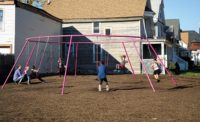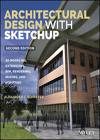New York Firm Comes Full Circle with African Conference Center












When they founded Work Architecture Company (WORKac), in an apartment facing a brick wall in 2003, Dan Wood and Amale Andraos had two jobs lined up: a bathroom renovation and a doghouse. A decade later, the firm is immersed in what looks like a dream commission: a huge circular conference center in which the government of Gabon—led by President Ali Bongo Ondimba—will host the next Summit of the African Union.
The 213,000-square-foot building, dubbed L’Assemblée Radieuse, is as formally complex as anything by OMA, where both Wood and Andraos, who are married, worked before starting their New York–based firm. But it also bears direct connections to the Gabon landscape, reflecting a strong environmental focus in the couple’s work. The building, Wood says, “is our answer to the question: How do you represent emerging progressive Africa to the world without relying on nostalgia or clichés?”
Andraos and Wood won the commission—their largest project to date—in July 2012, negotiated an agreement with the Gabon government in August, and began producing detailed drawings in September. The building was meant to host the summit in 2014, but even with a likely one-year delay, the job is on a fast track (with about 30 months between conception and completion). The architects formed a partnership with Epstein, the Chicago-based convention-center specialists, who moved dozens of employees into WORKac’s Lower East Side offices and brought in such consultants as facade specialists Front Inc.
The 320-foot-diameter building, in Libreville, Gabon’s capital, will have inward-tilting facades (making it a frustum—the base of a cone) and a raked roof that, from some vantage points, becomes the dominant elevation. Surrounding the circle are an inner wall of light gold-colored aluminum and an outer wall of fixed African limestone louvers. Between the two facades, a shaded walkway rings the building. The structure’s interior contains a 1,000-seat auditorium and three smaller theaters. Each of those is linked to a garden that represents one of Gabon’s ecosystems. (The landscape architect Nathan Browning has already established a nursery in Gabon, to get the plants ready for the opening.)
The curved inner walls of the courtyards are covered in reflective brass tiles, creating an effect that, Andraos says, will be surreal. The project is highly international. The African limestone for the building’s louvers will be honed in Italy. Local, sustainably harvested tropical wood is being shipped to Germany for fabrication into perforated acoustic panels for the auditoriums. Among the architects’ most interesting challenges was creating a sustainable protocol, borrowing provisions from the U.S., France, and England. “It was about picking and choosing the best practices,” says Wood, explaining that the Gabon government wants the building to set standards for future construction.
The louvers—consisting of slabs of stone supported by steel brackets—aren’t operable, but that’s not a problem in Gabon, since the equatorial location means there is no seasonal variation in sun position. Other green features of the conference building (which is expected to qualify for LEED Gold status) include a rooftop rainwater-collection system that will feed a waterfall that will then irrigate the gardens. That system is derived in part from Public Farm 1, WORKac’s summer 2008 installation at MoMA PS1, the Museum of Modern Art’s contemporary art space in Queens, New York. The resemblance between the conference center in Gabon, which could cost around $100 million (though no official budget has been released), and that largely architect-built experiment in urban agriculture is a credit to the firm’s consistency of vision.









